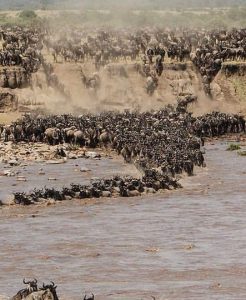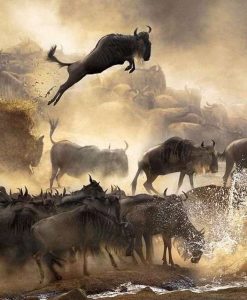THE KILIMANJARO PACKING LIST
If you are packing for your climb it is important to really plan your clothing appropriately. This is why we recommend that you pack the following:
- Top Base Layer
- Bottom Base Layer
- 4-5 Pairs of Underwear
- 3-4 Short Sleeve
- 1 Insulated Trekking Pants
- 1-2 Long Sleeve Hiking Shirts
- 1-2 Pairs of Hiking Trousers
- 1 Insulated Winter Jacket
- 1 Polartec Fleece Jacket
- 1 Hard Shell Jacket
- Make sure underwear has “flatlock” seams to prevent chafing and is anti-microbial
- Base layers are very important – choose merino wool or a combination of merino/synthetic for the best odor control and breathability
- Take an extra base layer to use for sleeping
- “Convertible” hiking pants are great for the lower slopes where it’s often warm enough to hike in shorts – try them out at home first to make sure they’re comfortable
- For the colder parts of the climb you’ll need good winter hiking pants – just make sure they’re breathable
- Waterproof pants with full-length zips make getting them on and off quick and easy
- Modern technical fleeces (such as Polartec) make excellent insulation layers
- If you’ve got a favorite hardshell jacket (such as a ski jacket) just make sure it’s big enough to fit over your other layers
- Don’t forget to bring a down jacket. You’ll need this for the summit bid as well as in the evenings at camp when you’re tired, you feel the cold a lot more.
- Get the best lightweight rain gear you can afford
- Your gloves are important: they protect you from the sun as well as keep you warm. Make sure your inner glove fits easily inside your thermal gloves/mittens
- Sunglasses are very important, they need to be 100% UV protective, and of the ‘wraparound’ variety. The sun at altitude is intensified and can reflect off ice and snow.
- A lot of heat is lost through your head, so be sure to get a warm thermal hat as well as one that protects your neck from the harsh rays of the sun.
Arguably the most important bit of kit you’ll need is your footwear. Make sure your hiking boots are well worn-in, that they fit properly (including with thick socks) and you are comfortable walking long hours in them. If you don’t have a favorite pair already, take your time choosing – don’t buy them online.
We recommend light- to mid-weight waterproof boots with good ankle support. You don’t need to go full-mountaineering boot, as you won’t be wearing crampons and you don’t need the extra weight. Sneakers or “trainers” are not appropriate, except for wearing around camp.
Your trekking boot needs to have a rugged, semi-rigid sole, and don’t forget to bring a spare pair of laces. Brands such as the Salomon GTX are a good example of a typical Kilimanjaro hiking boot.
Gaiters are a good idea to prevent mud, debris, and mountain scree from getting into your boots and causing irritation. They also keep the lower part of your pants clean.
Don’t skimp on your socks. Just as with your clothing layers, the liner sock needs to wick moisture away from your feet, and the outer sock provides cushioning and warmth. Avoid cotton socks.

Month-by-month guide for travelling in Tanzania
 This is the time to witness the great wildebeest migration in the Southern Serengeti and Ngorongoro. Exact locations for the best viewing of the migration can vary with each rain season as the migration moves according to the rain patterns. Between January and March, calving happens in the Southern plains of Serengeti. This is quite a spectacle as hundreds of thousands of wildebeest and zebra drop their calves, with predators on hunting. It is also the best time to watch large herds of elephant, large predators and hundreds species of birds in Tarangire national park.
This is the time to witness the great wildebeest migration in the Southern Serengeti and Ngorongoro. Exact locations for the best viewing of the migration can vary with each rain season as the migration moves according to the rain patterns. Between January and March, calving happens in the Southern plains of Serengeti. This is quite a spectacle as hundreds of thousands of wildebeest and zebra drop their calves, with predators on hunting. It is also the best time to watch large herds of elephant, large predators and hundreds species of birds in Tarangire national park.
 The best places to go during this time depend on the timing of the rainy season in any particular year. Some of the wildebeest migration herds will still be in parts of Southern Serengeti and some will be spread out from Southern plains to the central Serengeti areas, and slowly heading to into the western corridor of Serengeti.
The best places to go during this time depend on the timing of the rainy season in any particular year. Some of the wildebeest migration herds will still be in parts of Southern Serengeti and some will be spread out from Southern plains to the central Serengeti areas, and slowly heading to into the western corridor of Serengeti.
The best place to witness the great migration is the western corridor of the Serengeti, along the Grumeti River, Kirawira and Nyasirori plains. This is also the good time to explore Seronera area and Eastern Serengeti for all kinds of animal especially big cats. Central Serengeti is all year round accessible for game viewing activities. Explore Tarangire National Park, one of the greatest wildlife refuges in Africa with less number of tourists.
This is the best time and one of the highest seasons for visitors. The vegetation is relatively getting dry and animals gather around permanent water’s points. The wildebeest migration at this time will be around Mara River in the Northern Serengeti. This is the best time you can witness the migration crossing with crocodiles attack. Tarangire National Park is really worth visiting during this time as large herds of elephant, zebra and wildebeest are easily seen along the Tarangire River and Silalei Swamp while predators lying in wait.
This is the short rainy season the vegetation is turning greener and beautiful landscapes in Tarangire, Ngorongoro crater and Serengeti. While Christmas and New Year is the highest season to do safari in Northern Tanzania, November and December other than the holidays are relatively quiet times to come, though there’s still more to see. If you want to witness the great migration herds, it is likely to see them at Eastern, some parts of Central and Southern Serengeti. This is the best time to come as it is less crowded with tourists, so you will have a quieter experience while the wildlife is abundant.
Creating tailor-made tours for over 10 years
Due to Tanzania’s close proximity to the equator, we generally only have two seasons; a rainy season and dry season. Short rainy season is from November to January and long rainy season is March through May. Dry season usually starts from July to October.
Majority of people will suggest that the best time to visit Tanzania is between July to October. This is the dry season, means that animals wandering searching for water, which makes them relatively easy to spot. You will probably see them in large concentrations as the watering points and rivers are getting limited. Most of the water’s sources dry up or get smaller during the dry season. However because most people believe that July to October is the best time to come, it is also the busiest time in the national parks. This means that majority of people miss the hidden treasures that can be found at other times of the year.
Here is a short overview of what the year looks like in our National Parks.
Ideas and travel guides for exploring Tanzania
High Season
- From June to October
- It is the dry season
- Climate: Dry and warm, although there is short rains between August and September
- Higher rates applied Great Migration Mara River crossing
Recommended Itineraries
- Great Migration River Crossing
- Kilimanjaro and Safari adventure
- Cultural and Great Migration experience
- Serengeti Migration and Zanzibar
- Kenya and Tanzania Game Safari
- Tanzania Camping Safari
Mid Season
- From November to February
- It is the short rains season
- Climate: Short rains, hot and dry in some days
- Average rates applied
- Great Migration Southern Serengeti (Calving Season)
Recommended Itineraries
- Special Green Season
- Wildebeest Migration and Cultural Safari
- Tanzania Signature Safari
- Tanzania Luxury Safari
- Tanzania Safari Adventure
Low Season
- From March to May
- Long rain season
- Climate: Rainy days, occasionally warm
- Lower rates applied
- Great Migration safari Southern to central Serengeti
Recommended Itineraries
- Special Green Season
- Tanzania Highlights Safari
- Wildebeest Migration and Cultural Safari